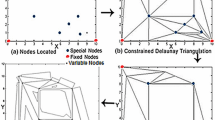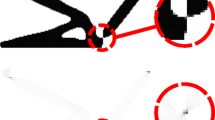Abstract
Topology optimization of compliant mechanisms is presented in this paper wherein the layout design problem is addressed in its original binary or discrete (0-1) form. Design variables are modeled as discrete variables and allowed to assume values pertaining only to their void (0) or solid (1) states. Due to this discrete nature, a genetic algorithm is employed as an optimization routine. Using the barrier assignment approach, the search algorithm is extended to use with multiple materials. The layout design of compliant mechanisms is performed wherein displacements at multiple points (ports) in the design region are maximized along the respective prescribed directions. With multiple output ports and multiple materials, additional freedom in motion and force transduction can be achieved with compliant mechanisms. Geometrically large deformation analysis is employed to compute the displacement-based multiple objectives that are extremized using Nondominated Sorting in Genetic Algorithms (or NSGA). With genetic algorithms, buckling or snap through like issues with nonconvergent solutions in the population when computing nonlinear deformations can be implicitly circumvented.
Similar content being viewed by others
References
Ananthasuresh GK, Kota S (1995) Designing compliant mechanisms. Mech Eng 117(11):93–96
Ananthasuresh GK, Kota S, Kikuchi N (1994) Strategies for systematic synthesis of compliant MEMS. In: Proceedings of the 1994 ASME winter annual meeting, Chicago, pp 677–686
Bailey SA, Cham JG, Cutkosky MR, Full RJ (2000) Biomimetic robotic mechanisms via shape deposition manufacturing. In: Hollerbach J, Koditschek D (eds) Robot Research: the ninth international symposium. Springer, Berlin Heidelberg New York
Canfield S, Frecker M (2000) Topology optimization of compliant mechanical amplifiers for piezoelectric actuators. Struct Multidisc Optim 20(4):269–279
Crisfield MA (1991) Nonlinear finite element analysis of solids and structures, vol 1. Wiley, Chichester, UK
Deb K, Agrawal S, Pratap A, Meyarivan T (2000) A fast elitist non-dominated sorting genetic algorithm for multi-objective optimization: NSGA-II. In: Proceedings of the conference on parallel problem solving from nature VI, Paris, 16–20 September 2000, pp 849–858
Frecker M, Ananthasuresh GK, Nishiwaki N, Kikuchi N, Kota S (1997) Topological synthesis of compliant mechanisms using multi-criteria optimization. ASME J Mech Des 119:238–245
Frecker M, Kikuchi N, Kota S (1999) Topology optimization of compliant mechanisms with multiple outputs. Struct Optim 17:269–278
Goldberg DE (2002) Genetic algorithms in search, optimization and machine learning. Addison-Wesley Longman, Reading, MA
Gordy MB (1996) Genetic algorithms toolbox for Matlab, v. 1.12, Federal Reserve Board
Howell LL, Midha A (1996) A loop-closure theory for the analysis and synthesis of compliant mechanisms. ASME J Mech Des 118:121–125
Jakiela MJ, Chapman C, Duda J, Adewuya A, Saitou K (2000) Continuum structural topology design with genetic algorithms. Comput Methods Appl Mech Eng 186:339–356
Jonsmann J, Sigmund O, Bouwstra S (1999) Multi degrees of freedom electro-thermal microactuators. In: Proceedings of TRANSDUCERS’99, pp 1372–1375
Mankame ND, Ananthasuresh GK (2002) Contact aided compliant mechanisms: concept and preliminaries. In: Proceedings of the ASME technical conferences on design and engineering, Montreal, 29 September 2002, Paper MECH 34211
Mankame ND, Ananthasuresh GK (2004) Topology synthesis of electro-thermal compliant mechanisms using line elements. Struct Multidisc Optim 26:209–218
Parsons R, Canfield S (2002) Developing genetic programming techniques for designing compliant mechanisms. Struct Multidisc Optim 24:78–86
Pedersen CBW, Buhl T, Sigmund O (2001) Topology synthesis of large-displacement compliant mechanisms. Int J Numer Methods Eng 50(12):2683–2706
Rajagopalan S, Goldman R, Shin KH, Kumar V, Cutkosky M, Dutta D (2001) Representation of heterogeneous objects during design, processing and freeform-fabrication. Mater Des 22:185–197
Rozvany GIN, Bendsøe MP, Kikuchi N (1995) Layout optimization of structures. Appl Mech Rev 48:41–119
Saxena A, Ananthasuresh GK (2000) On an optimality property of compliant topologies. Struct Multidisc Optim 19:36–49
Saxena A, Ananthasuresh GK (2001a) Topology design of compliant mechanisms with strength considerations. Mech Struct Mech Mech Struct Mach 29(1):199–221
Saxena A, Ananthasuresh GK (2001b) Topology synthesis of compliant mechanisms for nonlinear force-deflection and curved output path. ASME J Mech Des 123:33–42
Saxena R, Saxena A (2003) On design of electro-thermally compliant MEMS for strength. In: ASME technical conference on design engineering, Chicago, IL, 2–6 September 2003, DETC2003/DAC-48807
Sigmund O (1997) On the design of compliant mechanisms using topology optimization. Mech Struct Mach 25:495–526
Sigmund O (2001a) Design of multiphysics actuators using topology optimization. Part I: One-material structures. Comput Methods Appl Mech Eng 190(49–50):6577–6604
Sigmund O (2001b) Design of multiphysics actuators using topology optimization. Part II: Two-material structures. Comput Methods Appl Mech Eng 190(49–50):6605–6627
Sigmund O, Bruns TE, Tortorelli DA (2002) Numerical methods for the topology optimization of structures that exhibit snap-through. Int J Numer Methods Eng 55:1215–1237
Srinivas N, Deb K (1995) Multiobjective optimization using nondominated sorting in genetic algorithm. Evol Comput 2(2):221–248
Yin L, Ananthasuresh GK (2001) Topology optimization of compliant mechanisms with multiple materials using a peak function material interpolation scheme. Struct Multidisc Optim 23:49–62
Yin L, Ananthasuresh GK (2002) Novel design technique for electro-thermally actuated compliant micromechanisms. Sensors Actuators A Phys 97–98:599–609
Zhou M, Rozvany GIN (1991) The COC algorithm. Part II: Topological, geometrical, and generalized shape optimization. Comput Methods Appl Mech Eng 89:309–336
Author information
Authors and Affiliations
Corresponding author
Rights and permissions
About this article
Cite this article
Saxena, A. Topology design of large displacement compliant mechanisms with multiple materials and multiple output ports. Struct Multidisc Optim 30, 477–490 (2005). https://doi.org/10.1007/s00158-005-0535-z
Received:
Revised:
Published:
Issue Date:
DOI: https://doi.org/10.1007/s00158-005-0535-z




